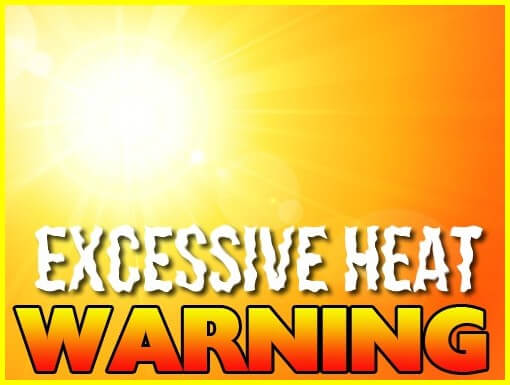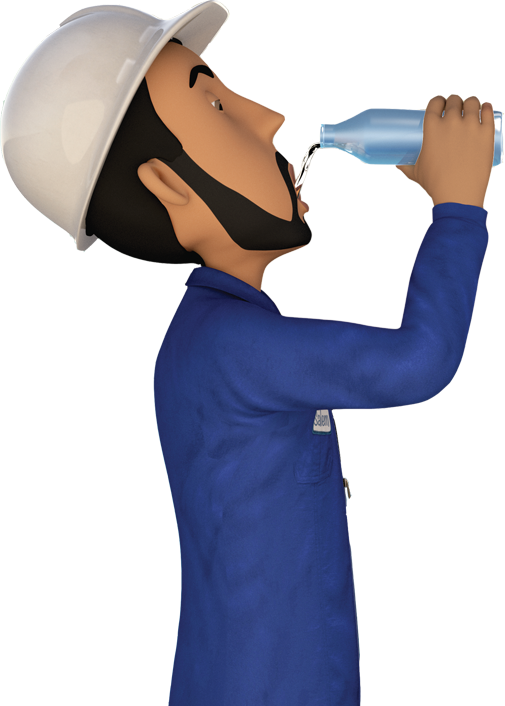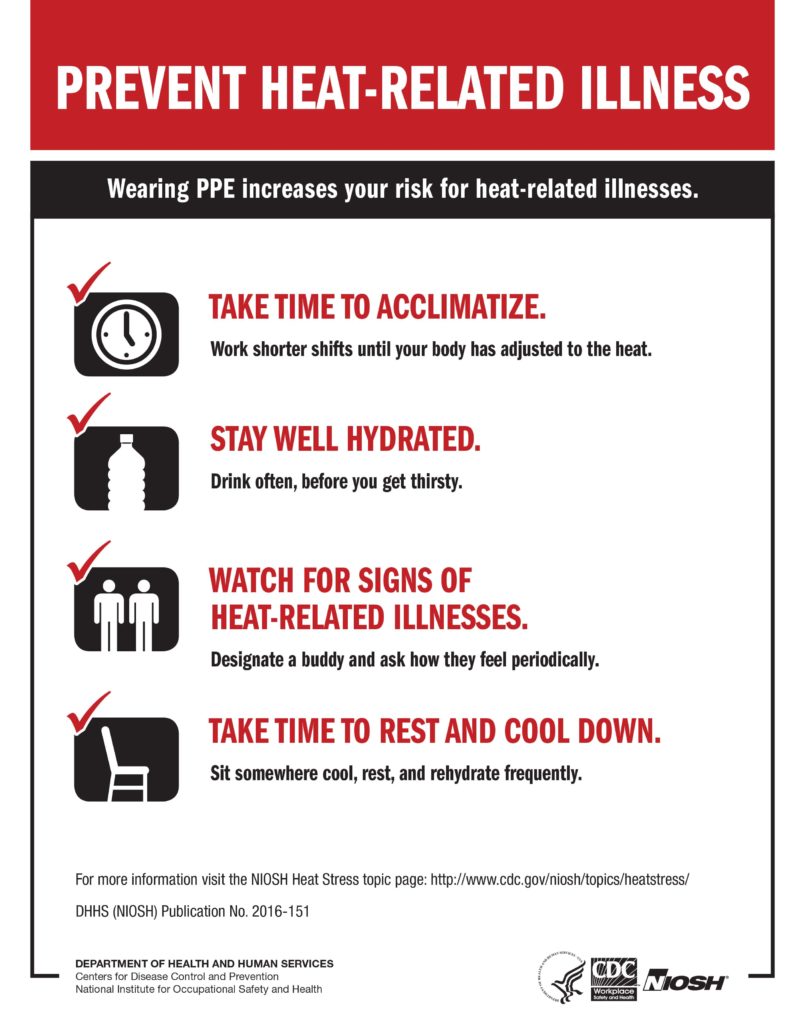
08 Aug Heat Safety
Protective Measures to Take During Excessive Heat

Water
Is there plenty of fresh, cool drinking water located as close as possible to the workers?
- Are water coolers refilled throughout the day? (Has someone been designated to check and make sure water is not running low?)
- Shade Is shade or air conditioning available for breaks and if workers need to recover?
Do workers know the:
Common signs and symptoms of heat-related illness?
- Proper precautions to prevent heat-related illness?
- Importance of acclimatization?
- Importance of drinking water frequently (even when they are not thirsty)?
- Steps to take if someone is having symptoms?
Emergencies
- Does everyone know who to notify if there is an emergency?
- Can workers explain their location if they need to call an ambulance?
- Does everyone know who will provide first aid?
Knowledgeable Person
- For high and very high/extreme heat index risk levels, is there a knowledgeable person at the worksite who is well-informed about heat-related illness and able to determine appropriate work/rest schedules and can conduct physiological monitoring as necessary?
Physiological Monitoring
- Are workers in the high or very high/extreme heat index risk levels being physiologically monitored as necessary?
Worker Reminders
- Drink water often
- Rest in shade
- Report heat-related symptoms early

Use the protective measures described for each risk level to help you plan ahead, and schedule and train your workers so that everyone is prepared to work safely as the heat index rises.
Actions for Low Risk Conditions: Heat Index Less Than 91°F
Actions for Moderate Risk Conditions: Heat Index is 91°F to 103°F
Actions for High Risk Conditions: Heat Index is 103°F to 115°F
Actions for Very High to Extreme Risk Conditions: Heat Index Greater Than 115°F
HEAT EXHAUSTION:
Heat exhaustion is one of the heat-related syndromes. Symptoms range in severity from mild heat cramps to heat exhaustion to potentially life-threatening heatstroke. Heat exhaustion can begin suddenly or over time, usually after working or playing in the heat, perspiring heavily, or being dehydrated.
Heat exhaustion signs and symptoms include:
- Cool, moist skin with goose bumps when in the heat
- Heavy sweating
- Faintness
- Dizziness
- Fatigue
- Weak, rapid pulse
- Low blood pressure upon standing
- Muscle cramps
- Nausea
- Headache
If you suspect heat exhaustion
Untreated, heat exhaustion can lead to heatstroke, which is a life-threatening condition. If you suspect heat exhaustion, take these steps immediately:
- Move the person out of the heat and into a shady or air-conditioned place.
- Lay the person down and elevate the legs and feet slightly.
- Remove tight or heavy clothing.
- Have the person drink cool water or other nonalcoholic beverage without caffeine.
- Cool the person by spraying or sponging with cool water and fanning.
- Monitor the person carefully.
Contact a doctor if signs or symptoms worsen or if they don’t improve within one hour.
Call 911 or your local emergency number if the person’s condition deteriorates, especially if he or she experiences:
- Fainting
- Agitation
- Confusion
- Seizures
- Inability to drink
- Core body temperature of 104 F (40 C) (heatstroke)

PRINTABLE CHECKLIST:
Additionally, check out the OSHA-NIOSH Heat Safety Tool as a useful resource for planning outdoor work activities based on how hot it feels throughout the day. Featuring real-time heat index and hourly forecasts, specific to your location, as well as occupational safety and health recommendations from OSHA and NIOSH.
The OSHA-NIOSH Heat Safety Tool features:

- A visual indicator of the current heat index and associated risk levels specific to your current geographical location
- Precautionary recommendations specific to heat index-associated risk levels
- An interactive, hourly forecast of heat index values, risk level, and recommendations for planning outdoor work activities in advance
- Editable location, temperature, and humidity controls for calculation of variable conditions
- Signs and symptoms and first aid information for heat-related illnesses





